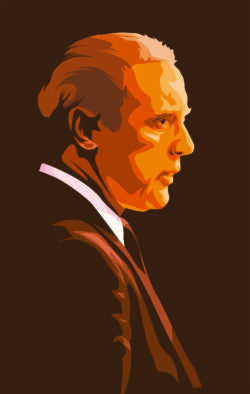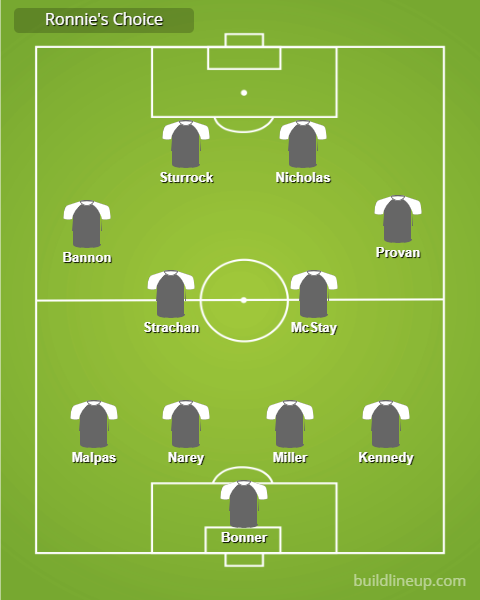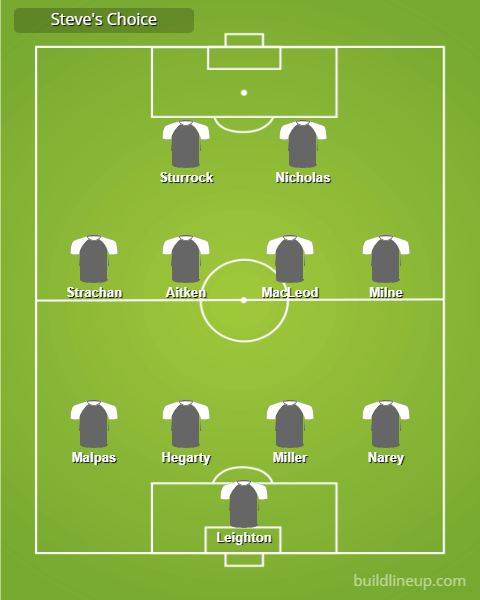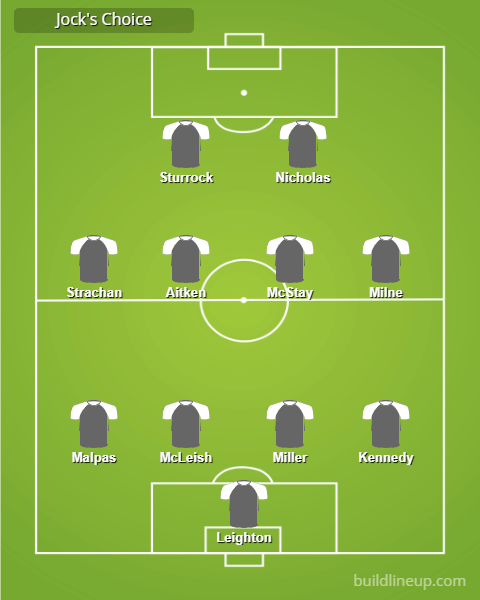
Jim McLean led Dundee United to the summit of Scottish football 40 years ago.
Forty years have passed since Jim McLean’s marvellous Dundee United side won the league for the first and only time, sealing the title on the final day of the season with a 2-1 derby win at Dens Park.
The Tangerines were deserving of glory that year, picking up momentum in the New Year and pulling into the lead towards the end of the season, a period that included critical away wins over title rivals Aberdeen (2-1) and Celtic (3-2).
But the season did not belong to United alone. After all, Celtic had won the League Cup in December, beating Rangers 2-1 in the final having gained a hard-fought 3-2 aggregate win over United in the semi. Aberdeen, meanwhile, had an incredible season, beating Bayern Munich and Real Madrid to win the European Cup Winners’ Cup before sealing the Scottish Cup ten days later. If you factor in the 1983 European Super Cup, which the Dons lifted compliments of a 2-0 aggregate win over Hamburger SV, the Dandies claimed an enviable calendar-year treble.
The close-run nature of the league campaign, which saw just one point separate the top three teams after all 36 games had been played, gives rise to an interesting question: if you were to compile a dream team from the trio of title contenders, who would you choose and why? With a hair’s breadth separating the collectives, which individuals would make the cut?
Defence and attack
A cursory glance at the league table suggests the lion’s share of attacking players would come from United and Celtic, who scored 90 goals apiece compared to the Dons’ 76. On the other hand, Aberdeen’s defence was stingier, with 24 goals against versus Celtic’s 36 and United’s 35. Naturally, this is barbershop debate territory with supporters of each club likely to give their players the edge in any hypothetical XI.
One point worth making before we dive into the selections is that even with an embarrassment of riches to choose from in virtually every position, there is no guarantee that a Dream Team would actually be superior to any of the three outfits competing for silverware that season. McLean’s United, Ferguson’s Aberdeen and McNeill’s Celtic were phenomenal examples of squads who put their bodies on the line and played for the badge. The three iconic managers ran incredibly tight ships and had been in their posts for a number of years (a full decade in McLean’s case) ahead of the 82-83 campaign, meaning each had a clear idea of how they wanted their teams to play and the personnel required to carry out their instructions.
There is the question, too, of who would manage a Dream XI and how long they would need to be in charge to get the most out of the 11. But that’s probably getting a bit too granular for the purposes of this article. Better to get started on choosing a goalkeeper.
Choose your goalkeeper
There might be no tougher choice than deciding who to put between the sticks: Celtic’s one-club man Pat Bonner, the Dons’ dependable Jim Leighton or United’s Hamish McAlpine, who would be named SFWA Footballer of the Year two seasons later.
Dundee United were crowned champions in 1983.
But given the pick of all the title contenders, @exoplanetocean asks: Who would make it into your Premier Division 82-83 Dream Team?
Let's start with the goalkeepers…https://t.co/qzdDozs5pu @dundeeunitedfc @AberdeenFC…
— NutmegMagazine (@NutmegMagazine) December 22, 2023
All were tremendous keepers who held the jersey for long spells and had fantastic moments that season. With no great deal of confidence I’ll go for Bonner, who had one of his finest games in a Celtic shirt when the Hoops beat Ajax 2-1 in the Netherlands in September.
Line up your defence
This is where it gets really interesting. Who do you put at right-back: Danny McGrain, Stuart Kennedy or Richard Gough? Left-back is between Maurice Malpas, Doug Rougvie or Mark Reid, while the central defensive berths have multiple Hall of Fame options in Willie Miller, Alex McLeish, Dave Narey, Paul Hegarty and Roy Aitken.
The easy answer for the latter, based on Aberdeen’s aforementioned GA tally, is to select Miller and McLeish, who formed one of the strongest centre-back pairings in Scottish football history. Indeed, the partnership represented the foundation of the Dons’ domestic success during the New Firm era, with Miller the powerful penalty-box defender and McLeish a commanding aerial presence. The duo also played alongside each other in over 50 international matches.
Nutmeg writer Ronnie McCluskey wants to know: Who would make it into your Premier Division 82-83 Dream Team?
Time to pick your left-back.https://t.co/qzdDozs5pu@dundeeunitedfc @AberdeenFC @CelticFC @exoplanetocean
— NutmegMagazine (@NutmegMagazine) December 22, 2023
But is it so cut and dry? Hegarty and Narey were towering centre backs in their own right, the former United’s greatest ever captain and his cultured compatriot Narey the club’s record appearance holder with 872 games. Then there’s Celtic’s Aitken, strong as a bull, a born leader and a future double-winning captain in the centenary season.
Nutmeg writer Ronnie McCluskey wants to know: Who would make it into your Premier Division 82-83 Dream Team?
Time to pick your right-back.https://t.co/qzdDozs5pu@dundeeunitedfc @AberdeenFC @CelticFC @exoplanetocean
— NutmegMagazine (@NutmegMagazine) December 22, 2023
It’s an extremely tough call but I’m going to risk Aberdeen fans’ ire and team up Narey and Miller, who played together in the 1982 World Cup games against Brazil (a 4-1 loss with Narey scoring a belter) and the Soviet Union (2-2). As for the full-backs, Malpas is the obvious choice at left-back: not only is he United’s greatest ever in that role, he may just be Scotland’s. Right-back’s a difficult one but Celtic captain McGrain was getting on in years and Gough was just a pup: Stuart Kennedy – fearless, fit as a dog and an attacking threat on the flanks – gets my vote.
Nutmeg writer Ronnie McCluskey wants to know: Who would make it into your Premier Division 82-83 Dream Team?
Time to pick your central defensive pair from: Willie Miller, Alex Mcleish, Dave Narey, Paul Hegarty, Roy Aitken.
(And bear with us 🙈. This is where Twitter polls…
— NutmegMagazine (@NutmegMagazine) December 22, 2023
What’s your midfield make-up?
With a brilliant back four to keep the door shut at the other end, which midfielders do we put at the top of our Class of 83? There are so many great players to choose from but let’s start in the middle of the pitch.
The title-winning United side relied on three exceptional players in this area – Billy Kirkwood, John Holt and Derek Stark. Celtic, for their part, had Murdo MacLeod, Paul McStay and sometimes Tommy Burns, while the Dons relied on some combination of Gordon Strachan and Neale Cooper (when they weren’t on the right), John McMaster and Dougie Bell. Narey and Aitken could also deputise in the midfield.
Nutmeg writer Ronnie McCluskey wants to know: Who would make it into your Premier Division 82-83 Dream Team?
Time to name your central midfield pair. Which two are you picking from this list and why?
Billy Kirkwood
John Holt
Derek Stark
Murdo MacLeod
Paul McStay
Tommy Burns…— NutmegMagazine (@NutmegMagazine) December 22, 2023
It’s impossible to make a bad choice here. I’ll go with Paul McStay – the PFA Scotland Young Player of the Year – and Gordon Strachan, who was instrumental in Aberdeen’s success that year. Both were extremely hard working and composed in possession, with excellent vision.
Nutmeg writer Ronnie McCluskey wants to know: Who would make it into your Premier Division 82-83 Dream Team?
Time to pick your left-sided midfielder.https://t.co/qzdDozs5pu@dundeeunitedfc @AberdeenFC @CelticFC @exoplanetocean
— NutmegMagazine (@NutmegMagazine) December 22, 2023
On the left wing, there are several excellent choices to choose from in Eamonn Bannon, Tommy Burns and the Dons’ Peter Weir and John Hewitt, who famously scored the goal that downed Real Madrid in Gothenburg.
Nutmeg writer Ronnie McCluskey wants to know: Who would make it into your Premier Division 82-83 Dream Team?
Time to pick your right-sided midfielder.https://t.co/qzdDozs5pu@dundeeunitedfc @AberdeenFC @CelticFC @exoplanetocean
— NutmegMagazine (@NutmegMagazine) December 22, 2023
On the right, it’s between Neale Cooper, Ralph Milne (who doubled as a striker) and Davie Provan. Bannon, whose services had been secured by United for a Scottish record £165,000 in 1979, is my pick on the left flank. He could do it all: run, shoot, take corners, free-kicks and penalties, fire dangerous crosses into the box; he was comfortable with both feet, physically strong and fearless. On the opposite wing, after much humming and hawing, I’m going for Davie Provan. The classy, attack-minded winger was indispensable to that Celtic team and a deserving man of the match in the Old Firm League Cup final win in December.
Select your goal-getters
So, who gets the nod up top? I don’t think there’s much debate about one of them – Charlie Nicholas. The hitman finished the season with 53 goals for Celtic and Scotland, earning him the Scottish PFA Player of the Year and SFW Player of the Year awards and a big-money move to Arsenal.
Nutmeg writer Ronnie McCluskey wants to know: Who would make it into your Premier Division 82-83 Dream Team?
Time to name your strikers. 53-goal Charlie Nicholas gets in by default. But who partners him?
— NutmegMagazine (@NutmegMagazine) December 22, 2023
But who do you pair with Champagne Charlie? Prolific poacher Davie Dodds, who notched 30 goals in all competitions? Paul Sturrock, who got half as many but loads of assists? Ralph Milne or Eric Black who bagged 21, or Mark McGhee who scored 27 including half a dozen in Europe?
I’ll say it again: there’s no bad choice here. Despite his comparatively weaker goal tally compared to the others, my pick is Paul Sturrock. Nicholas and Luggy were the duo favoured by Ferguson when Scotland played Denmark in their 1986 World Cup opener and although they lost the game 1-0, I believe it’s a partnership that could bear serious fruit.

This team has everything: a figure of authority between the posts, a powerful defensive unit, a dynamic midfield with pace and precision, and two inventive, terrorising strikers.
The Dundee United fan’s choice
In preparation for writing this piece, I reached out to a few supporters of the clubs in question (being a Hoops supporter, I’ll count the aforementioned text as the Celtic perspective). One was author Steve Finan, who has written books about all three clubs but is a passionate Dundee United man.
After selecting the “highly impressive” Leighton in the sticks, Steve “pushed Dave Narey to right-back as Scotland often did in the 80s, because he is such a good player he couldn’t be left out. Richard Gough might seem an odd omission, but he was only 20 and not quite yet the superb defender he would be six or seven years later. Malpas is the most underrated player of my XI; his ability to properly defend and stop crosses coming in is something that is rare. Very few defenders do their best work 40 yards from goal but Maurice did.”

In central defence Steve teamed up Paul Hegarty (“I always thought Hegarty was better in the air than McLeish”) and Willie Miller, and compiled a midfield quartet of Milne, Aitken, MacLeod and Strachan. “MacLeod or Bannon was a toughie; Bannon was a good player but his real value was the ability to receive the ball and then move United up the park 30, 40, 50 yards. It is difficult to leave him out. But Murdo was a powerful man, he drove on relentlessly. Roy Aitken couldn’t be left out either. The big man was and is a born winner. As for Strachan, little explanation is needed – he unlocked defences.”
Like me, Steve went with Nicholas and Sturrock up top. “The prospect of a Sturrock/Nicholas pairing is quite fascinating. Sturrock made everyone around him a better player. Davie Dodds benefited from that immensely.”
Although non-United supporters may feel the Tangerines are over-represented in this XI, “I actually surprised myself that I have only five United players in it. I agonised over John Holt instead of MacLeod for a balance between defence and attack, and also, as mentioned, Bannon/MacLeod. I perhaps should also point out that this 11 would need to play together for three solid seasons before they got really good!”
The Aberdeen fan’s choice
Lifelong Red and Aberdeen trustee Jock Gardiner, for his part, had Jim Leighton in goals, a back four of Kennedy, McLeish, Miller and Malpas, and a midfield of Strachan, Aitken, McStay and Milne (though he debated including his personal favourite Neale “Tattie” Cooper). His strike force? Sturrock and Nicholas. Jock went one further, saying he’d make Alex Ferguson the manager with Jim McLean and Billy McNeill as assistants.

Amusingly, I solicited the view of another Aberdeen fan who organises the weekly seven-a-side game I play in. His blunt response: “Basically, the Aberdeen team with Nicholas in for McGhee and shoehorn Sturrock in somehow.” After some back and forth, he conceded he would play Malpas ahead of Rougvie at left full-back.
So, let the debate commence. Who makes your Premier Division Dream Team 82-83?


